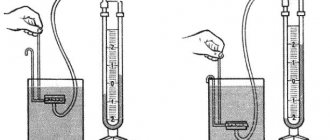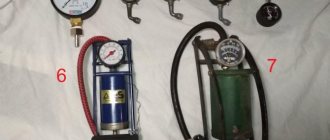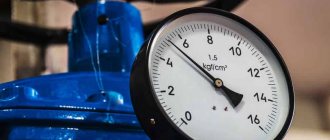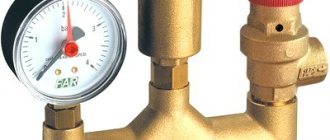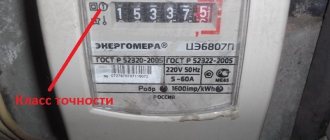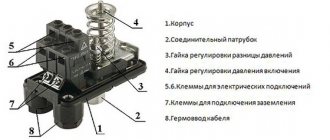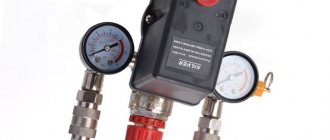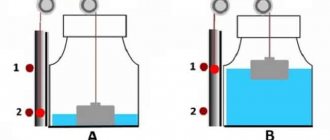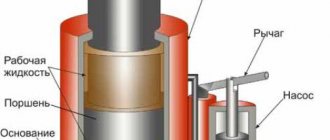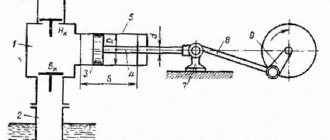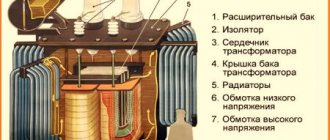Classification of pressure measuring instruments
Classification of pressure measuring instruments
Depending on their purpose, pressure measuring instruments are divided into the following main groups: Pressure gauges - for measuring excess pressure.
Vacuum gauges – for measuring vacuum pressure (vacuum). Pressure and vacuum gauges – for measuring vacuum and excess pressure. Barometers – for measuring atmospheric pressure. Bar vacuum gauges – for measuring absolute pressure. Differential pressure gauges – for measuring pressure differences. According to the operating principle, all pressure measuring devices can be divided into:
Liquid - devices in which the measured pressure is balanced by the weight of a liquid column, and the change in the level of liquid in communicating vessels serves as a measure of pressure, are called liquid. This group includes cup and U-shaped pressure gauges, differential pressure gauges, etc.
Weight piston devices are devices in which the measured pressure is balanced by the force created by calibrated weights acting on a piston freely moving in the cylinder.
Devices with remote transmission of readings are devices that use changes in certain electrical properties of a substance (electrical resistance of conductors, electrical capacitance, the appearance of electrical charges on the surface of crystalline minerals, etc.) under the influence of the measured pressure. Such devices include manganin resistance pressure gauges, piezoelectric pressure gauges using quartz crystals, tourmaline or Rochelle salt, capacitance pressure gauges, ionization pressure gauges, etc.
Spring - devices in which the measured pressure is balanced by the elastic forces of a spring, the deformation of which serves as a measure of pressure. Due to their simplicity of design and ease of use, spring devices are widely used in technology. This group includes a variety of instruments that differ in the type of springs: pressure gauges with a tubular spring, pressure gauges with a plate spring, pressure gauges with a box spring, absolute pressure gauges (pressure gauges), differential pressure gauges.
According to their metrological purpose, measuring instruments are divided into standard and working. Exemplary measuring instruments are devices intended for verification of other measuring instruments. Exemplary pressure gauges have the following accuracy classes:
0.05; 0.2 — deadweight piston pressure gauges; 0.16; 0.25; 0.4 - spring pressure gauges. Working measuring instruments are all measuring instruments used for direct measurements. Working pressure gauges have accuracy classes 0.4; 0.6; 1.0; 1.5; 2.5; 4.0.
Types of measured pressure
Pressure is one of the key thermotechnical quantities, the most important parameter of many technological processes.
Pressure transducers are designed to measure and continuously convert pressure into a unified DC or voltage output signal.
Converters are used in regulators and other automation devices in systems for automatic monitoring, regulation and control of technological processes in water treatment, heating, ventilation and air conditioning systems; hydraulic systems, refrigeration equipment, flow meters and counters; diesel engines; brake systems; level gauges, test benches, etc.
Industrial measurements and instrumentation are used in all areas of industry - from nuclear to food and pharmaceutical; Accordingly, pressure converters are needed everywhere.
The principle of operation of the sensors is based on the elastic deformation of the sensitive element (sensor), on which semiconductor strain gauges are applied, connected according to a Winston bridge circuit. The measured pressure is supplied through the fitting into the working cavity of the sensor and causes deformation of the diaphragm. This leads to a change in the geometry of the resistors that are in close mechanical connection with it and a change in their resistance. This converts the applied pressure (mechanical input) into a change in resistance (electrical output).
Pressure transducers measure the difference between two pressures acting on the measuring membrane (sensing element) of the sensor. One of these pressures is the measured one, the second is the reference one, that is, the pressure relative to which the measured one is measured. Depending on the type of reference pressure, all converters are divided into the following types. Absolute pressure transducers Designed to measure the absolute pressure of liquid and gaseous media. The reference pressure is vacuum. The air from the internal cavity of the sensor's sensitive element has been pumped out. For example, a barometer is a special case of an absolute pressure sensor.
Excess pressure transducers Designed to measure the excess pressure of liquid and gaseous media. Reference pressure - atmospheric; thus, one side of the membrane is connected to the atmosphere.
Differential (difference, drop) pressure transducers are designed to measure the difference in pressure of a medium and are used to measure the flow of liquids, gas, steam, and liquid level. Pressure is applied to both sides of the membrane, and the output signal depends on the pressure difference.
Hydrostatic pressure converters Designed to convert hydrostatic pressure of a controlled medium into a direct current signal. The pressure of a liquid column is measured, depending only on its height and on the density of the liquid itself.
Vacuum pressure (vacuum) transducers are designed to measure the vacuum pressure of liquid and gaseous media. The reference pressure in these sensors is also atmospheric. However, unlike gauge pressure sensors, the measured pressure is less than atmospheric pressure, i.e. there is a vacuum relative to the atmosphere.
Excess pressure-discharge converters are a combination of excess and vacuum pressure sensors, i.e. measure both pressure and vacuum.
For reliable operation of sensors, it is necessary to select materials of elements in contact with the medium being measured (diaphragms, flanges and sealing rings) that are chemically resistant to these media. For example, for various operating environments, the sensor membrane material can be stainless steel, titanium, titanium alloy, ceramics, etc.
Pressure converters also differ in climatic design. You should pay attention to the climatic conditions (ambient temperature, humidity, direct exposure to water and sunlight) at the location where the sensor is installed. They must correspond to those for which it is designed.
Pressure transducers have different metrological characteristics (accuracy classes) - usually from 0.05% to 0.5%. Particularly precise transducers are used at critical sites in various industries.
Some types of pressure sensors are explosion-proof. These models can be successfully used to determine pressure at explosive sites with the presence of explosive and flammable gases and liquids.
Pressure transducers are classified as measuring equipment and must undergo mandatory certification tests. After this, they are approved and entered into the State Register of Measuring Instruments.
Research work on the topic “Measurement of body pressure”
A student’s project work on the current topic “Measuring the pressure of bodies.”
The work discusses laboratory workshops on the study of body pressure, theory, and examples in drawings.
Development content
RESEARCH WORK ON THE TOPIC
“MEASURING BODY PRESSURE”
The work was completed by a 7G grade student of school No. 2033
Balaeva Zhanna Eduardovna
Head: physics teacher
OBJECTIVE: TO MEASURE THE PRESSURE OF A SOLID BODY ON THE SUPPORT AND FIND OUT WHAT THIS QUANTITY DEPENDS ON.
- Find out what instruments are used to measure the pressure exerted by various bodies?
2. Why measure blood pressure?
3. Calculate area:
— the student’s feet without shoes, without changing mass;
- Calculate the area of support on 2 legs.
4 . Measure the force acting on the support.
Conclusions:
As a result, I achieved the specified goal; I learned that if the area of an object is larger, then the pressure is less. If the area is smaller, then the pressure is greater.
round base body
PRESSURE MEASURING DEVICES
Instruments used to measure water pressure at the depth of the sea are called pressure gauges.
Instruments for measuring atmospheric pressure are called barometers - aneroids.
To measure the pressure created by solids I used p
= F/S
Pressure is a physical quantity that characterizes the stressed state of a medium (liquid or gaseous).
Pressure occurs as a result of the action of force on the surface of a body. It determines the thermodynamic state of substances. Pressure largely determines the progress of the technological process, the state of technological devices and their operating modes. The task of measuring pressure is encountered in measuring certain technological parameters, for example, gas or steam flow, with changing thermodynamic parameters, liquid level, etc. Increased or decreased pressure (non-compliance with the regime) during the technological process in any apparatus can lead to loss product quality at the final stage of the process.
Pressure can be atmospheric (the pressure of the near-Earth atmosphere), excess (exceeding atmospheric) and absolute (the sum of atmospheric and excess). Absolute pressure below atmospheric is called rarefied, and deep rarefaction is called vacuum.
The unit of pressure in the International System of Units (SI) is Pascal (Pa).
One Pascal is the pressure created by a force of one Newton over an area of one square meter. Since this unit is very small, units that are multiples of it are also used: kilopascal (kPa) = Pa; megapascal (MPa) = Pa, etc.
The variety of types of measured pressures, as well as the areas of their application in technology, has led to the use of non-system units along with the system pressure unit. These include bar, millimeter of mercury, kilogram-force per square centimeter, kilogram-force per square meter, millimeter of water.
Pressure instruments are used to monitor and control technological processes. These devices are used for direct or indirect comparison of the measured value with a measure. In industrial installations, the most common gauges are excess pressure gauges, which usually have a zero reference point (from atmospheric pressure). Narrow-limit pressure gauges are also used - pressure gauges with a non-zero scale.
Instruments for measuring pressure are divided into:
Pressure gauges – for measuring absolute and gauge pressure; Barometers - for measuring the barometric pressure of atmospheric air [1]. Pressure meters are pressure gauges of excess pressure in gaseous media with an upper limit of measurement of no more than 40 kPa (for measuring small excess pressures (upper limit of measurement of no more than 0.04 MPa) Vacuum gauges are instruments for measuring the pressure of rarefied gas (vacuum); Traction meters are vacuum gauges for measuring the pressure of rarefied gas with an upper limit of measurement of no more than 40 kPa. Pressure and vacuum gauges - intended for measuring excess pressure and pressure of rarefied gas (vacuum). Thrust and pressure gauges are pressure and vacuum gauges for gas media with an upper limit of measurement of no more than 20 kPa, for measuring vacuums and small excess pressures; Differential pressure gauges are instruments that measure the difference between two pressures.
Pressure gauges are used to measure constant and variable pressure in the direction. Constant pressure is considered to be pressure that does not change or changes smoothly over time at a rate of no more than 1% / sec. from the sum of the upper measurement limits of the instruments. Variable pressure is considered to be pressure that smoothly and repeatedly increases or decreases according to any periodic law at a rate of 1 to 10% / s of the sum of the upper measurement limits.
According to the principle of operation, pressure measuring instruments are divided into the following:
— Liquid — based on balancing the measured pressure of the corresponding liquid column.
— Deformation (spring) — measuring pressure by the amount of deformation of various elastic elements or by the force they develop.
— Deadweight piston — in which the measured pressure is balanced by an external force acting on the piston.
- Electrical - based either on the conversion of pressure into one of the electrical quantities, or on a change in the electrical properties of the material under the influence of pressure. Such a division is not complete and can be supplemented by measuring instruments based on other physical phenomena.
Liquid pressure measuring instruments with hydrostatic balancing.
In liquid devices with hydrostatic balancing, the measure of pressure measured is the height of the column of working fluid. Distilled water, mercury, ethyl alcohol, and transformer oil are used as a working fluid, called a barrier or manometric fluid. The choice of working fluid is determined by the range of pressure being measured, operating conditions and the required measurement accuracy. Currently, the range of liquid pressure measuring instruments with hydrostatic balancing is significantly limited. In most cases, they are replaced by more advanced deformation measuring instruments. Liquid pressure measuring instruments (pressure difference and vacuum) with hydrostatic balancing that are also used on process flows include float and bell differential pressure gauges. The operating principle of float differential pressure gauges is based on balancing the measured pressure difference with the hydrostatic pressure created by the column of working fluid filling the differential pressure gauge. A float differential pressure gauge consists of two communicating vessels. The area of one vessel is much larger than the other. The internal cavity of the communicating vessels is filled with working fluid (mercury or transformer oil) to the zero mark. Bell differential pressure gauges of this type are a bell immersed in a working fluid and moving under the influence of a pressure difference. The counterforce is created by making the bell heavier as it rises and by reducing the bell's weight as it sinks. This is achieved by changing the hydrostatic lift force acting on the bell according to Archimedes' law. Bell differential pressure gauges with hydrostatic balancing are highly sensitive and have been used to measure low pressures, differential pressures and vacuums.
Deformation pressure measuring instruments.
High accuracy, simplicity of design, reliability and low cost are the main factors responsible for the widespread use of deformation pressure measuring instruments in industry. These devices are designed to measure excess pressure and discharge of non-aggressive liquid and gaseous media. The operating principle of deformation pressure measuring instruments is based on the use of elastic deformation of the sensing element or the force developed by it. The measure of the measured pressure in measuring instruments of this type is the deformation of the elastic element or the force developed by it. Three main forms of sensing elements are most widespread in measurement practice: tubular springs, bellows and membranes. A tubular spring (Bourdon spring) is an elastic curved metal hollow tube, one of the ends of which can move, and the other is rigidly fixed. Tubular springs are used primarily to convert the measured pressure applied to the interior of the spring into proportional movement of its free end. The most common is a single-turn tubular spring, which is a tube bent in a circular arc with a usually oval cross-section. Under the influence of applied excess pressure, the tube unwinds, and under the influence of vacuum it twists. To transmit the movement of the free end of the strain-sensitive element to the pressure gauge pointer, sector and lever transmission mechanisms are used. With the help of a transmission mechanism, movement of the free end of a tubular spring of several degrees or millimeters is converted into an angular movement of the pointer of 270 - 300 g. Pressure gauges have different scales depending on the parameter being monitored and are calibrated in kgf/cm2. The working area of the pressure gauge is in the middle of the scale and should be no more than 2/3 of the scale. A bellows is a thin-walled cylindrical shell with transverse corrugations capable of receiving significant movements under the influence of pressure or force. Under the action of an axial load, external or internal pressure, the length of the bellows changes, increasing or decreasing depending on the direction of the applied force. Bellows are made from bronze of various grades, carbon steel, stainless steel, aluminum alloys, etc. Seamless and welded bellows with a diameter of 8 - 10 to 80 - 100 mm and a wall thickness of 0.1 - 0.3 mm are mass-produced. Devices of this type are designed to measure excess pressure, vacuum and pressure difference. Membranes are elastic and elastic. An elastic membrane is a flexible round flat (flat membrane) or corrugated (corrugated membrane) plate that can deflect under pressure. Membranes are made from various grades of steel, bronze, brass, etc. An elastic membrane, designed for measuring low pressures and pressure differences, consists of flat or corrugated disks clamped between flanges, made of rubberized fabric, Teflon, etc. Measuring instruments with sensitive membrane element are designed to measure atmospheric and excess pressure and vacuum. Due to the small forces developed by the sensitive deformation element, membrane devices are mainly produced as indicating devices. The principle of operation of the devices is to convert the measured pressure or vacuum into the movement of the rigid center of the sensitive membrane element, which, using a transmission mechanism, is converted into the rotational movement of the pointer.
Deadweight piston pressure gauges.
Deadweight piston pressure gauges are mainly used as reference and standard instruments for calibration and verification of various types of spring pressure gauges, since they differ from other types of pressure gauges in their high accuracy and wide measurement range. The principle of operation is to balance the pressure acting on the piston on one side with the pressure of the loads on the other side.
Electrical pressure measuring instruments.
Electrical means of measuring pressure include currently produced pressure transducers based on the direct conversion method, which differ both in the type of strain-sensitive element and in the method of converting its movement or the force it develops into a signal of measuring information. For conversions, inductive, differential transformer, capacitive, strain gauge and other converting elements are used. Inductive pressure transducers - a membrane that senses pressure and is a movable armature of an electromagnet. Under the influence of the measured pressure, the membrane moves, which causes a change in the electrical resistance of the inductive converting element.
